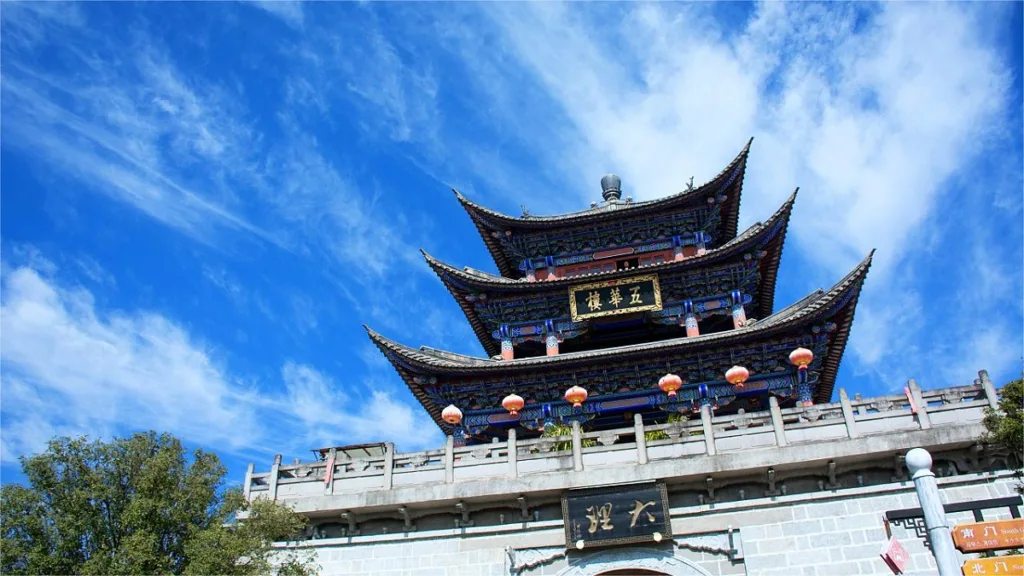Fuxing Road is the main thoroughfare in Dali Ancient Town, running from south to north. Its construction dates back to the 15th year of the Hongwu reign of the Ming Dynasty (1382 AD), when Dali Ancient Town was the capital of the Dali Kingdom. Throughout the Qing Dynasty and into the Republican era, the layout and architecture of the street remained largely unchanged. By the 1990s, Dali Ancient Town had become a major tourist destination, and Fuxing Road evolved into a pedestrian street known for its locally characteristic tourist products such as tie-dye clothing, Heqing silverware, Dali marble crafts, Burmese jade, Pu’er tea, dried fruits, and more.
The highlight of Fuxing Road is the cherry blossoms in spring and the annual International Orchid Tea Expo. The buildings lining Fuxing Road maintain a quaint, elegant style, with uniform blue-gray tiled roofs complementing the gray-blue slate pavement. These buildings, weathered by time, bear witness to the historical changes of the ancient town. In the evening, warm lights from the shops on both sides cast gentle shadows on the slate pavement, creating a serene and cozy atmosphere.
Table of Contents
- Basic Information
- Location and Transportation
- Highlights of Fuxing Road
- Other Attractions in Dali Old Town
Basic Information
| Estimated Length of Tour | 1 – 2 hours |
| Ticket Price | Free |
| Opening Hours | 24 hours a day throughout the year |
| Telephone Number | 0086-0872-2670396 |
Location and Transportation
Fuxing Road is the main thoroughfare running from south to north within Dali Ancient Town, located in Dali City, Yunnan Province, China. To get there, you can take bus Gucheng 1 and get off at Yu’er Park Stop (玉洱公园站).
Highlights of Fuxing Road
South Gate Tower

Dating back to the 15th year of the Ming Dynasty’s Hongwu reign, the South Gate Tower, also known as Shuanghe Gate (Two Cranes Gate), holds mythical significance in local folklore. Legend has it that the ancestors of Dali arrived in this fertile land following two immortal cranes, hence the town’s nickname “Hetao,” which means “crane spreading.” Touching the weathered bricks of this ancient structure evokes a sense of the passage of six centuries. As you walk westward along the city wall, the mist-covered Cangshan Mountain draws nearer. Green plants grow delicately in the crevices of the bricks, a testament to the harmonious coexistence of nature and history. In the 40th year of the Kangxi reign of the Qing Dynasty, the phrase “文献名邦” was inscribed on the tower, praising Dali’s abundant talents and extensive collection of classics. The South Gate Tower is unique in the nation for housing a Buddhist shrine behind its gates, reflecting Dali’s historical embrace of Buddhism.
Du Wenxiu Mansion

Located in the middle section of Fuxing Road, the former residence of Du Wenxiu, now the Dali City Museum, stands as a symbol of resistance against the Qing Dynasty. Built in the second year of the Kangxi reign, it served as the Yunnan Provincial Governor’s Office. In 1856, Du Wenxiu led a rebellion against the Qing Dynasty, capturing the governor’s office and establishing himself as the “Supreme Commander of the Army.” Despite his efforts, the uprising failed in 1872. In a bid to prevent the massacre of thousands of civilians, Du Wenxiu and his family consumed poison, with Du Wenxiu swallowing a peacock gallstone and dressing in ceremonial attire before presenting himself to the Qing army camp, where he died at the age of 49. The Qing government later restored the governor’s office, which was converted into the Dali City Historical Museum in 1988. The museum houses historical relics, exhibition halls, courtyards, and a stele forest, offering visitors insights into the region’s turbulent past.
Wuhua Tower

Ascending Wuhua Tower provides an unparalleled panoramic view of Dali, enveloping visitors in the dust of bygone eras. Built during the reign of Duan Fengyou of the Nanzhao Kingdom in 856 AD, Wuhua Tower served as a state guesthouse at that time. Reconstructed on its original site in 1999, historical records describe Wuhua Tower as spanning five miles in circumference, standing a hundred feet tall, with the capacity to accommodate ten thousand people on its upper level and fly five flags on its lower level. Comprising both a bell tower and a drum tower, Wuhua Tower resonates with the chimes of both instruments when dignitaries arrive. As the highest point in the ancient city, this towering edifice’s soul silently narrates the ever-shifting sands of time.
Dali Confucian Temple

Originally constructed during the Yuan Dynasty, the Dali Confucian Temple stood on the eastern side of Mishijie Street in Dali Ancient Town (now adjacent to Dali No.1 Middle School). Unfortunately, it was destroyed by fire during the Xianfeng period of the Qing Dynasty. In 1873, during the same period, the temple was merged with Dali Prefecture’s temple and relocated to Baoguo Temple, its present site (which houses the Dali Cultural Museum and Dali City Library today), and renamed Dali Confucian Temple. In 1885, upon the initiative of Cen Yuying, the Governor-General of Yunnan and Guizhou, the temple was reconstructed on the original site of Baoguo Temple. The rebuilt Dali Confucian Temple features complete and grand architectural complexes, with buildings oriented from west to east in a symmetrical axial layout, showcasing the unique architectural style of ancient Dali.





